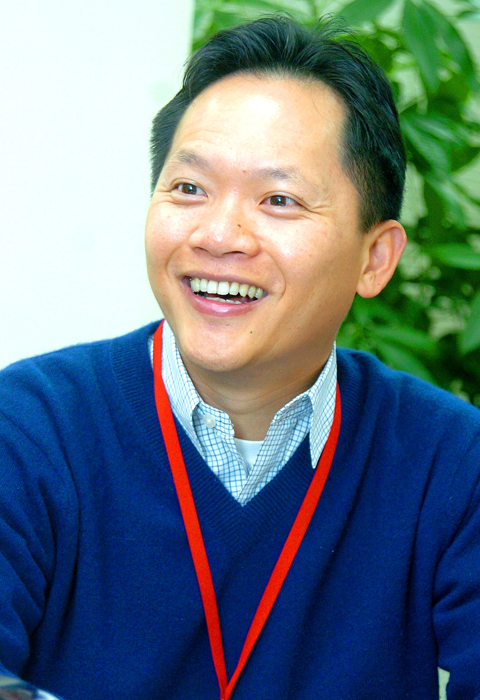You may not know the software company DeviceVM Inc (達維飛碼), based in San Jose, California, but you could be familiar with its product, which is used by several computer vendors.
Asustek Computer Inc (華碩) labels DeviceVM’s “instant-on” technology as “Express Gate” on its laptops, which allows the computers to boot-up in a few seconds.
Lenovo Group Ltd (聯想) calls its notebooks’ quick-boot function “Quick Start,” while Hewlett-Packard Co says its printers can produce faster printouts with zero warm-up time, thanks to this time-saving operating system platform.

PHOTO: CHANG CHIA-MING
Founded in 2006 by a team of Massachusetts Institute of Technology graduates, with offices in Taipei, Shanghai, Hangzhou and San Jose, DeviceVM has strong roots in Taiwan.
The software startup received its initial funding from major Taiwanese technology industry heavyweights such as Asustek, Acer Inc (宏碁), Hon Hai Precision Industry Co (鴻海精密) and HTC Corp (宏達電) and essentially rode on the netbook boom. Its “instant-on” technology is sold pre-installed on personal computers made by global vendors.
Prior to the Consumer Electronics Show (CES) in Las Vegas last month, DeviceVM stayed largely out of the public eye while reaping a steady stream of revenue every time a computer is purchased.
“We focused on marketing synergy,” Mark Lee (李明勳), DeviceVM’s chief executive officer, said of the start-up’s strategy to cobrand with various PC makers rather than to promote the “instant-on” technology under its Splashtop brand.
“We didn’t insist on showcasing our brand because we understand the need for PC vendors to strengthen theirs and create customized solutions for their discerning clients. But if you look closely, you’ll see the words ‘powered by Splashtop’ when our pre-OS platform opens up. We have insisted on this branding guideline with every manufacturer we work with,” Lee said in an interview with the Taipei Times on Jan. 16.
“Cooptition” is how Lee terms DeviceVM’s relationship with PC vendors — a combination of “collaboration” and “competition.”
He sees computer makers as business partners, yet recognizes the fact that these partners can turn into competitors at anytime and introduce their own versions of quick-boot capabilities.
Lee said there was no way of knowing where rivals will pop up until a product actually rolls out. He said he was somewhat relieved by the cost-cutting underway at every major tech company around the world because the chances that companies would spend R&D money to develop proprietary “instant-on” technology appears unlikely right now.
Instead of waiting for competitors to surface, however, DeviceVM is mapping out a global presence. By opening up its Splashtop platform to developers worldwide, it hopes to gain a wide array of different usage models and attract even more end users.
Lee said DeviceVM hoped to develop a strong and irreplaceable ecosystem of Splashtop users and strengthen its platform dominance the way Microsoft did with Windows OS.
Lee envisions Splashtop being deployed in other hardware devices through “convergence” — the inter-linkage between computing and IT, media content and communication networks that has risen because of the Internet’s explosion in popularity.
“At CES, Intel and Yahoo announced a partnership to bring Web content to televisions; this is a perfect example of convergence. Intel is leveraging on its success in building central processing units [CPUs] for PCs into the TV industry, just like it did recently with the introduction of Atom processors to reach into ultra mobile devices,” Lee said.
In essence, wherever Intel goes, it paves the way for DeviceVM. From Splashtop’s “instant-on” technology in netbooks running on Atom processors, DeviceVM can easily expand Splashtop into the handheld device market as well. The possibilities for Splashtop to migrate into other hardware devices are endless, Lee said.
The third leg of Lee’s long-term vision is perfecting DeviceVM’s technology to stay ahead of the game.
The company plans to transform Splashtop into a “virtual” platform that allows users to perform simple tasks on the pre-OS platform, while simultaneously booting up Windows in the background, he said.
“One core can run Splashtop, while the rest can be used to power up Windows. It’s a very effective use of computing power,” Lee said.
Additional features will be created to enable users to switch to and from Splashtop platform to programs such as Word, Excel or PowerPoint, he said.
Lee said the IT industry was heading toward a shift to cloud computing in the near future as value and content move onto the Internet.
“New business models and services will be recreating the whole industry, making software expertise ever more valuable,” he said.
This is something that Taiwan will not want to miss, he said.
Lee and his team hope to see Taiwan as a world-class IT center. To Lee, software and hardware expertise are critical in building this complete IT center. While Taiwan has a solid foundation in hardware, its weakness lies in software development, he said.
Lee and DeviceVM are working to foster local software talents. The company tries to recruit some of the brightest minds in the country while introducing them to cutting-edge software ideas from the US. Device VM now has 200 employees, with 180 engineers based in Asia, Lee said. In time, these young engineers will become local software leaders and strengthen Taiwan’s software expertise, he said.

CAUTIOUS RECOVERY: While the manufacturing sector returned to growth amid the US-China trade truce, firms remain wary as uncertainty clouds the outlook, the CIER said The local manufacturing sector returned to expansion last month, as the official purchasing managers’ index (PMI) rose 2.1 points to 51.0, driven by a temporary easing in US-China trade tensions, the Chung-Hua Institution for Economic Research (CIER, 中華經濟研究院) said yesterday. The PMI gauges the health of the manufacturing industry, with readings above 50 indicating expansion and those below 50 signaling contraction. “Firms are not as pessimistic as they were in April, but they remain far from optimistic,” CIER president Lien Hsien-ming (連賢明) said at a news conference. The full impact of US tariff decisions is unlikely to become clear until later this month

With an approval rating of just two percent, Peruvian President Dina Boluarte might be the world’s most unpopular leader, according to pollsters. Protests greeted her rise to power 29 months ago, and have marked her entire term — joined by assorted scandals, investigations, controversies and a surge in gang violence. The 63-year-old is the target of a dozen probes, including for her alleged failure to declare gifts of luxury jewels and watches, a scandal inevitably dubbed “Rolexgate.” She is also under the microscope for a two-week undeclared absence for nose surgery — which she insists was medical, not cosmetic — and is

GROWING CONCERN: Some senior Trump administration officials opposed the UAE expansion over fears that another TSMC project could jeopardize its US investment Taiwan Semiconductor Manufacturing Co (TSMC, 台積電) is evaluating building an advanced production facility in the United Arab Emirates (UAE) and has discussed the possibility with officials in US President Donald Trump’s administration, people familiar with the matter said, in a potentially major bet on the Middle East that would only come to fruition with Washington’s approval. The company has had multiple meetings in the past few months with US Special Envoy to the Middle East Steve Witkoff and officials from MGX, an influential investment vehicle overseen by the UAE president’s brother, the people said. The conversations are a continuation of talks that

CHIP DUTIES: TSMC said it voiced its concerns to Washington about tariffs, telling the US commerce department that it wants ‘fair treatment’ to protect its competitiveness Taiwan Semiconductor Manufacturing Co (TSMC, 台積電) yesterday reiterated robust business prospects for this year as strong artificial intelligence (AI) chip demand from Nvidia Corp and other customers would absorb the impacts of US tariffs. “The impact of tariffs would be indirect, as the custom tax is the importers’ responsibility, not the exporters,” TSMC chairman and chief executive officer C.C. Wei (魏哲家) said at the chipmaker’s annual shareholders’ meeting in Hsinchu City. TSMC’s business could be affected if people become reluctant to buy electronics due to inflated prices, Wei said. In addition, the chipmaker has voiced its concern to the US Department of Commerce